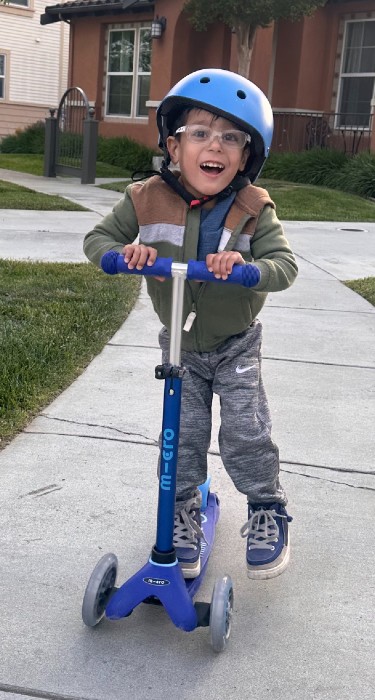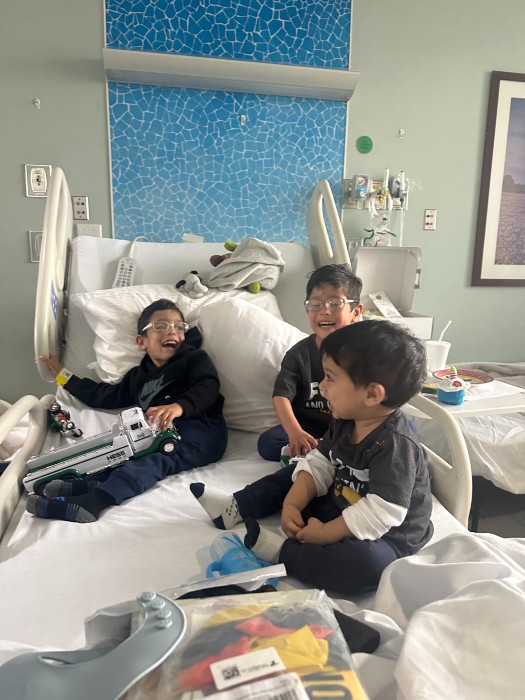 Asefa Dani, 39, was pregnant with twin boys during the height of COVID-19 in late 2020 when she learned, during routine testing, that her body was not able to carry the boys to full term. Asefa’s doctor, located in her home city of San Francisco, Calif., gave her grim advice.
Asefa Dani, 39, was pregnant with twin boys during the height of COVID-19 in late 2020 when she learned, during routine testing, that her body was not able to carry the boys to full term. Asefa’s doctor, located in her home city of San Francisco, Calif., gave her grim advice.
“At 20 weeks, the doctor told me my cervix was open prematurely and suggested I abort the pregnancy. ‘Abort! Abort! Abort,” Asefa recalls hearing over and over. “They said that babies born this early don’t live.”
Asefa and her husband, Farhan, 39, understood the odds. They knew that, according to the American College of Obstetricians and Gynecologists (ACOG), a baby born between 20 and 25 weeks of gestation is considered a periviable birth—one with an extremely low chance of survival.
But the couple decided to go ahead with the pregnancy. Asefa put herself on bedrest, taking early maternity leave from her job as a private client manager at a major bank. “I wanted to give my miracle babies a chance to survive,” she said.
Three weeks later, on Jan. 26, 2021, Asefa gave birth to identical twins Zayn and Omar. The micro-preemies were born at 23 weeks; Zayn weighed 1 pound, 3 ounces at birth, Omar weighed 1 pound, 1 ounce.
Premature Twin Diagnosed with Cerebral Palsy
At 6 months of age and now home from the hospital, the twins were progressing at different rates. Zayn wasn’t sitting up or crawling like his brother Omar, who was steadily meeting his milestones.
That’s when doctors diagnosed Zayn with spastic diplegia, a form of cerebral palsy that primarily affects the lower extremities. Individuals with spastic diplegia experience severe muscle tone and stiffness, often accompanied by muscle spasms, which can make it difficult to control leg movements.
Doctors told Zayn’s parents that his cerebral palsy was caused by the grade 4 intraventricular hemorrhage (IVH) he suffered at birth. The damage from the IVH led to scarring in his brain.
The Twins Turn 3
Zayn started walking right around the time he turned 3 years old, but, again, he didn’t move the way his twin did. “Zayn fell a lot. Like 20 times a day. He saw Omar walking and wanted to follow but couldn’t. His legs were really stiff and he couldn’t control them,” explained Asefa.
Zayn wore braces on his feet for support and received frequent physical and occupational therapy every week. He was making unbelievable progress with his walking, his mom recalled.
However, six months later, in the summer of 2024, Zayn suddenly regressed to crawling. Asefa recalled him saying, “it hurt too much to walk.”
“It was a setback for him,” Asefa said. “He did start to walk again eventually but we decided we didn't want him to ever have another setback like that. That’s when I began to look into surgery.”
The Search for the “Best” Surgeon
Asefa dove into research, joining multiple online cerebral palsy support groups and reading countless posts from other parents discussing surgical options, outcomes and top specialists. One name began to be highly circulated in parental discussions online: Manish N. Shah, MD, a pediatric neurosurgeon affiliated with the Children’s Neuroscience Center at Children’s Memorial Hermann Hospital in Houston, Texas.
Dr. Shah and his team offer a procedure called Selective Dorsal Rhizotomy (SDR), a neurosurgical technique used to reduce spasticity in children with cerebral palsy. During the surgery, nerve fibers in the spine that are sending abnormal signals to the leg muscles are carefully identified and selectively cut. By reducing these signals, SDR can significantly improve mobility, balance, and quality of life—especially for children with spastic diplegia.
Children’s Memorial Hermann Hospital is one of the few pediatric neuroscience programs in the country offering single-level laminectomy SDR procedures for children with cerebral palsy who suffer from spastic diplegia or spastic hemiplegia.
In addition to offering the less-invasive, specialized surgical procedure, after surgery Dr. Shah strives to connect his patients with the highest quality inpatient rehabilitation as soon as possible at TIRR Memorial Hermann, one of the nation’s best rehabilitation hospitals according to U.S. News & World Report. Together with Stacey Hall, DO, medical director of Pediatric Physical Medicine and Rehabilitation at TIRR Memorial Hermann, Dr. Shah developed the SDR Pathway program at TIRR Memorial Hermann. Dr. Shah believes that early surgical intervention, combined with intensive physical therapy, is key to success for patients like Zayn.
“There wasn’t a question for us. We made a virtual appointment with Dr. Shah right away,” Asefa said. “We wanted the and the best in-patient rehabilitation facility available and we were willing to travel to get that care for Zayn.”
Zayn’s information and records were sent to Dr. Shah, and, in October 2024, he agreed Zayn was a great candidate for SDR surgery at Children’s Memorial Hermann Hospital. The following month, Farhan and his son, Zayn, traveled to Houston to meet Dr. Shah in person. The surgery date was set for Jan. 21, 2025.
“I can’t even describe the level of confidence Dr. Shah has while also being one of the most humble people we’ve ever met,” Asefa said. “We were impressed by his bedside manner and I instantly knew we had chosen the right surgeon.”
Historic Snowstorm Threatens to Delay Surgery
 Asefa and Zayn arrived in Houston on Jan. 19, ahead of the surgery scheduled for two days later. “The weather reports were crazy. They were expecting the biggest snowstorm the city had seen in 30 years,” Asefa recalled. “I have a friend who lives there and she advised us to reschedule the surgery. She said there is no way they are going to perform the surgery as planned during the storm.”
Asefa and Zayn arrived in Houston on Jan. 19, ahead of the surgery scheduled for two days later. “The weather reports were crazy. They were expecting the biggest snowstorm the city had seen in 30 years,” Asefa recalled. “I have a friend who lives there and she advised us to reschedule the surgery. She said there is no way they are going to perform the surgery as planned during the storm.”
However, a call to Dr. Shah’s team put those concerns to rest. Christy, Dr. Shah’s patient coordinator and 'right hand person,' assured Asefa that the hospital has generators and that Dr. Shah would perform Zayn’s surgery first thing on Tuesday, Jan. 21—even if he had to walk through the storm to do it."
As promised, when the time came to begin, the entire surgical team was ready to go. In fact, they (including Dr. Shah) slept at the hospital overnight so Zayn’s surgery would proceed without delay. (No traveling in the snow required!)
True to his word, Dr. Shah performed the SDR procedure on Zayn. “SDR surgery is designed to reduce lower extremity spasticity in children with cerebral palsy,” Dr. Shah explained. “We achieve this by cutting the spastic nerve fibers in the spinal cord to reduce muscle tone, improving mobility and quality of life for the patient.”
Zayn’s surgery lasted five hours, but Dr. Shah was extremely pleased with the outcome.
“Truthfully, I wasn’t nervous. I had complete faith in Dr. Shah every step of the way,” Said Asefa.
Asefa also praised the nurses for their exceptional care. “The care we received from the nurses was outstanding. Everyone was so happy and positive. You could tell that the employees at Children’s Memorial Hermann Hospital are truly valued—they were genuinely happy to be there. We felt like VIPs,” she said. “The entire team slept at the hospital after the surgery, too, because everyone was snowed in!”
Walking Well Thanks to ‘Amazing Therapists’
The day after surgery, Zayn was already sitting up. The following day, he started physical therapy. By the end of the week, Zayn was transferred to TIRR Memorial Hermann for inpatient pediatric rehabilitation.
TIRR Memorial Hermann has a specialized SDR pathway and provides specialized rehabilitation for cerebral palsy patients who have undergone SDR surgery. Guided by a multidisciplinary team, the rehabilitation unit care focuses on comprehensive recovery for pediatric patients to maximize motor function and quality of life. This recovery unit is unique to TIRR Memorial Hermann and is one of the only units of its kind in the country.
Farhan, Asefa’s mother, brought Omar and the twin’s younger brother, Adam, 1, to their temporary Houston home rental that weekend. The family stayed in Houston for more than four weeks until Zayn was discharged from TIRR Memorial Hermann.
Asefa will never forget the day they left TIRR Memorial Hermann for the last time. “Zayn did not want to leave. He said he wanted to stay there forever. He formed a special bond with one of his favorite physical therapists and even wanted her to come home with him,” she said.
While most patients leave in a wheelchair, Zayn walked out on his own. It can take months for a patient to return to where they were before surgery, and even longer to truly be on the road to recovery, Asefa explained. "But Zayn made incredible progress so quickly, all thanks to his amazing therapists." She added, "I know he wouldn’t have come so far, so fast, if it wasn’t for the rehab at TIRR Memorial Hermann."
Zayn is on the Move
Two weeks after returning to California, Zayn, now 4, was strong enough to go back to preschool. “He is walking. He saw his twin running and he wanted to follow,” mom said. “He no longer falls as much and is getting stronger and gaining better balance. His core will take a little longer to strengthen, but for now, Zayn is mobile and independent. We are so happy we chose Dr. Shah to perform his surgery.”
Zayn goes to physical rehabilitation three times a week and does more therapy every day on the machine the family has at home. He just learned how to ride a scooter and his parents are looking forward to the day when he is able to get on a bicycle and ride off. Zayn is also taking swimming classes. But, most of all, he loves being with his twin brother.
Asefa said she was told the amount of rehabilitation Zayn needs is likely to taper off over the next year or so. And, she hopes, someday he won’t need his braces anymore. The family will continue virtual progress appointments with Dr. Shah until the first anniversary of the surgery. That’s when they plan to take another trip to Houston for an in-person visit.
“At Children’s Memorial Hermann Hospital, we had the very best experience I can imagine having. The entire staff was so good. We felt like everyone we encountered was at the highest possible level. The therapists were the best of the best,” Asefa said. “And, it’s important to point out that we are from the San Francisco Bay Area, which is home to some of the best hospitals in the world. Children’s Memorial Herrmann Hospital and TIRR Memorial Hermann are next level.”
Learn more about the Children’s Neuroscience Center »
Learn more about the Selective Dorsal Rhizotomy procedure »
Learn more about inpatient pediatric rehabilitation at TIRR Memorial Hermann »
Contact Us
To contact Children's Memorial Hermann Hospital, please fill out the form below.
If you are experiencing a medical emergency, call 911 or go to the nearest emergency room.
If you or someone you know needs support from the Suicide and Crisis Lifeline, call or text 988.